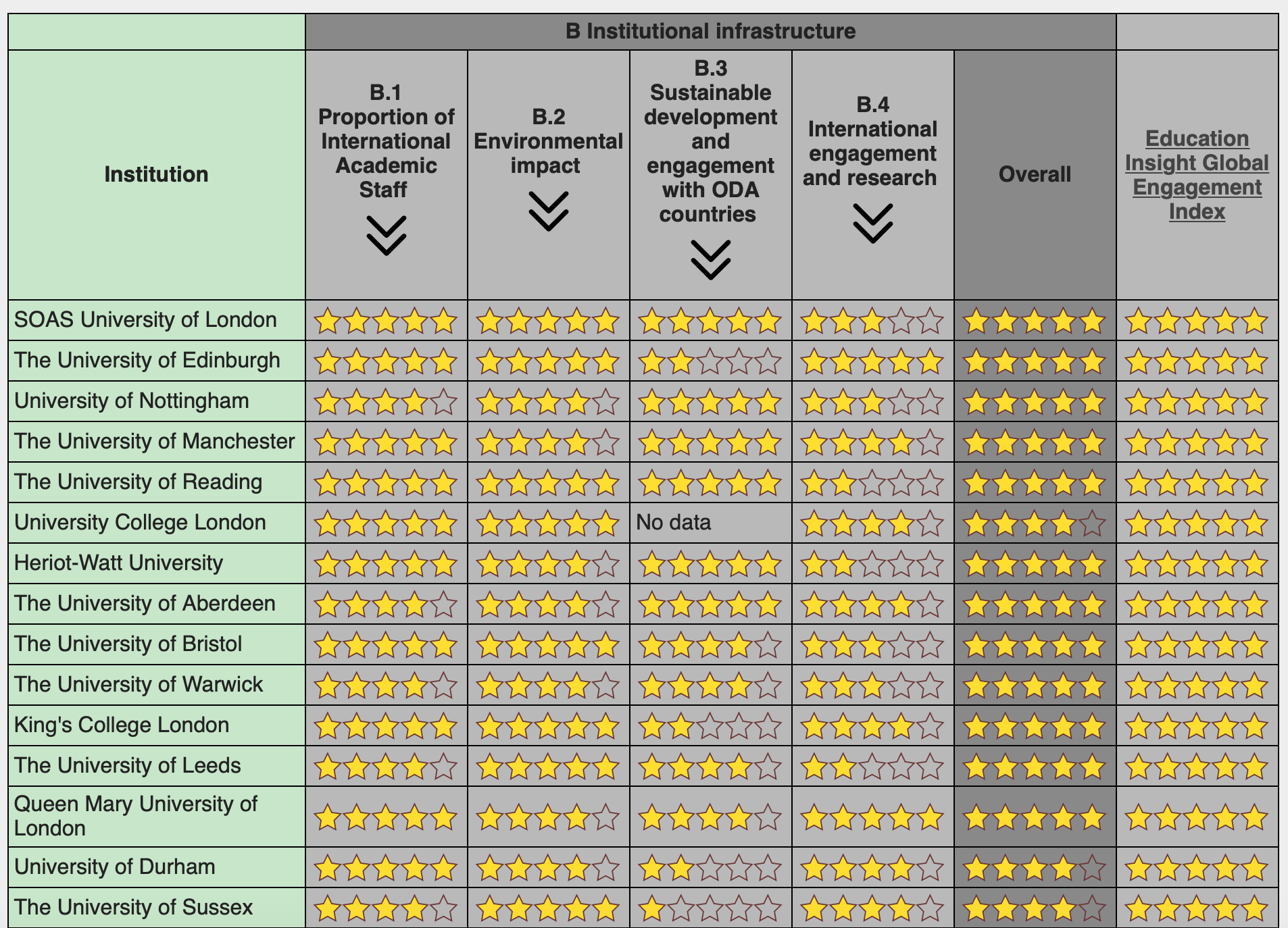There are many international university rankings of one sort or another – which we have covered here at various times.
Many of them claim to offer helpful insights into the international positionings of universities but really as we know they provide very little benefit to students, applicants, universities or their staff.
It’s good to be able to report something a bit different therefore which actually might be of some value to universities in the UK. The new Global Engagement Index (GEI) from Education Insight, an education consultancy, has just been published on the PIE site.
The GEI
endeavours to support the development of institutional internationalisation strategies and invite a conversation about global engagement. The index aims to capture the state of international engagement across 30 measures, which have varying relevance to the UK’s diverse higher education sector. The scores range from five stars, highest level of engagement, to one star, which indicates a low level of engagement or that the measure bears little relevance.
A snapshot of one subset of results gives a flavour – it is very much an index rather than a ranking.

It’s a very broad and comprehensive set of indicators which spans student and institutional engagement – you can see the full details of each one here.
Part A: Student Engagement
A.1 Diversity of International Students
A.1.1 Proportion of International Students
A.1.2 Market Diversification
A.1.3 Student Recruitment from ODA Countries (countries in receipt of “Official Development Assistance” from the Organisation for Economic Co-operation and Development (OECD))
A.2 HESA Aggregate Offshore Record
A.2.1 Transnational Education for Capacity Building
A.2.2 Delivery of Transnational Education
A.3 Student Success
A.3.1 Continuation Rate of First Degree International Students
A.3.2 Student Satisfaction (NSS)
A.3.3 Proportion of International Leavers in Study or Employment
A.4 Study Abroad and Internationalisation at Home
A.4.1 Proportion of Modern Foreign Language Students
A.4.2 Proportion of Students with Study Abroad Experience
A.4.3 Proportion of Incoming Visiting and Exchange Students
A.4.4 International Themes Within the Curricula
Part B: Institutional Infrastructure
B.1 Proportion of International Academic Staff
B.2 Environmental impact
B.3 Sustainable development and engagement with ODA countries
B.4 International engagement and research
There is a lot of detail in each of these areas, and much more to emerge I am sure. Two particularly interesting facts were shared with me in a discussion with the compiler:
- The detailed analysis undertaken on completion rates has shown that the percentage of successful outcomes for international undergraduate students appears to be significantly higher than for domestic students
- Fifty-seven per cent of UK universities’ trans-national education (TNE) is delivered to students in ODA countries. This demonstrates that universities are concerned with development partnerships as much as focusing on potentially more financially lucrative international operations.
Some other points emerging from other indicators are rather notable:
- The data mining of curricula gives an indication of the wide range of international elements embedded in curricula.
- The capacity building approach of UK universities – a really important and under-estimated aspect of TNE (ie it’s not about the money) is demonstrated through the measure which considers the engagement of HEIs in the delivery of transnational education at the postgraduate level as a proportion of the overall TNE delivery.
- The metric covering the proportion of transnational education in ODA countries shows HEIs’ engagement through TNE in countries and territories which attract ODA. I’m not sure we’ve seen this kind of data before.
- Then there is also the proportion of students with some study abroad experience as part of their degrees which is a broad and important indicator of wider international student engagement.
I do think this is a really interesting and helpful project. There’s a lot of detail in here which I’m sure universities will find useful and there is much more on the Education Insights web page including a tool universities can use to compare their own position with their peers as well as providing comparisons across the range of indicators.













Thanks Paul. Good to see Nottingham “up there” and from what I can see it is only using UK data (e.g. “This metric uses the 2018-19 HESA staff record and is reduced to just academic staff”). Imagine if we could include our two international campuses.
Excellent point, Graham. The index is limited to the availability statistical data, HEIs are global players, and as such, a data return which reflects their global footprint is required. I have addressed this partly in the student engagement section, but it is missing from the institutional infrastructure.
Hi Graham, be careful in how you interpret being “up there”. UoN, like others, does very well in some measures of global engagement but less well in others. Of course it’s for you to decide which measures are important so doing less well in X may not be an issue. I’ll let you play with the benchmarking tool to see where Nottingham drops out of the top quintile and what if anything that says about the strategy. As Janet has also said, this is a first attempt at trying to capture a wider set of measures of global engagement but… Read more »